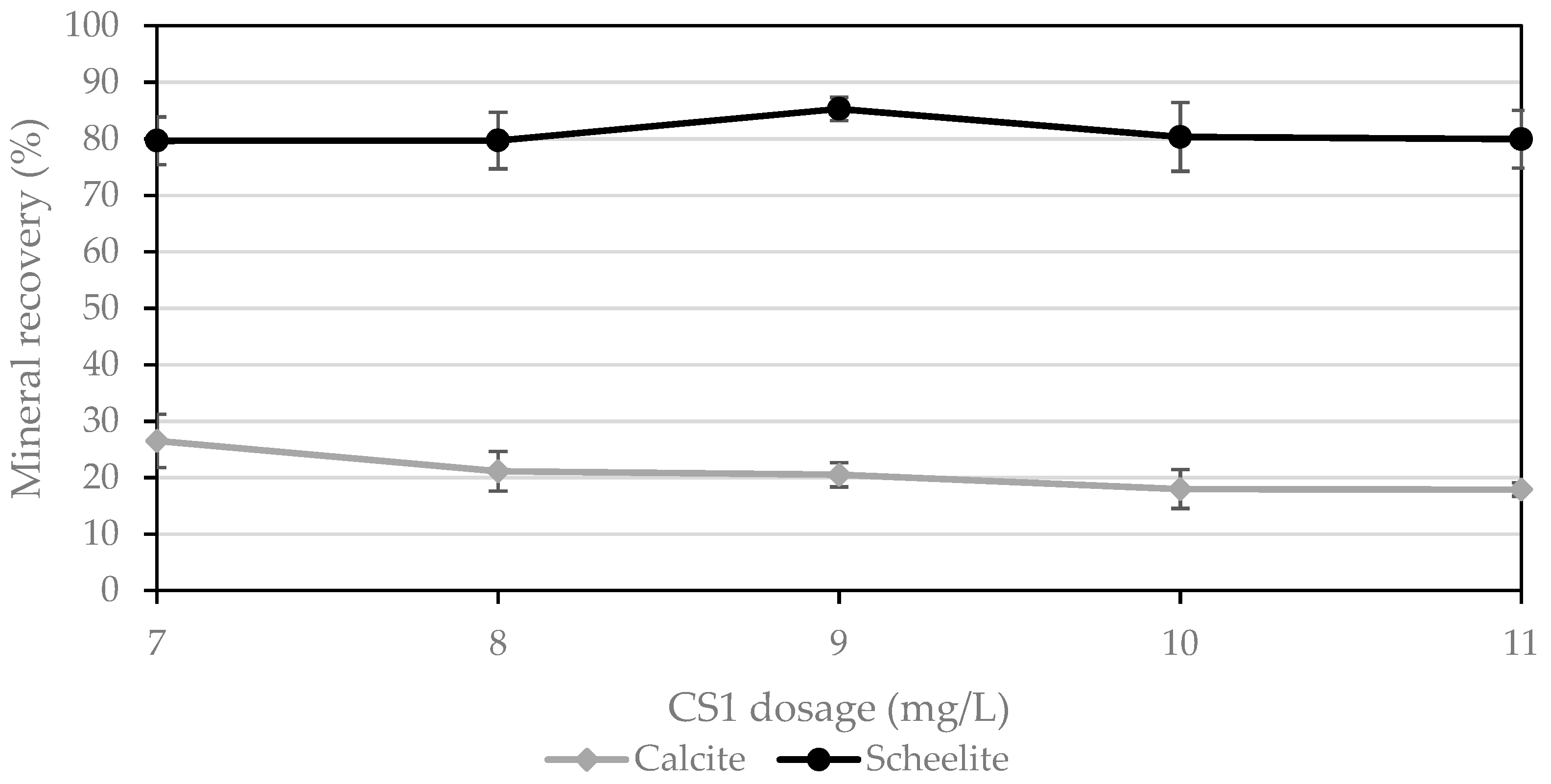The Potential Role of Colloidal Silica as a Depressant in Scheelite Flotation
Abstract
:1. Introduction
2. Materials and Methods
3. Performance of Colloidal Silica in Scheelite Flotation
3.1. Proof of Principle
3.2. Impact of Colloidal Silica Size
3.3. Impact of Colloidal Silica Dosage
3.4. Effect of pH
4. Link to Sodium Silicate
5. Conclusions
Author Contributions
Funding
Acknowledgments
Conflicts of Interest
References
- Kupka, N.; Rudolph, M. Froth flotation of scheelite—A review. Int. J. Min. Sci. Technol. 2018, 28, 373–384. [Google Scholar] [CrossRef]
- Martins, J.I.; Amarante, M.M. Scheelite Flotation from Tarouca Mine Ores. Miner. Process. Extr. Metall. Rev. 2012, 34, 367–386. [Google Scholar] [CrossRef]
- Yongxin, L.; Changgen, L. Selective flotation of scheelite from calcium minerals with sodium oleate as a collector and phosphates as modifiers. I. Selective flotation of scheelite. Int. J. Miner. Process. 1983, 10, 205–218. [Google Scholar] [CrossRef]
- Fuerstenau, M.; Gutierrez, G.; Elgillani, D.A. The influence of sodium silicate in nonmetallic flotation systems. In Transactions; AIME: New York, NY, USA, 1968; pp. 319–323. [Google Scholar]
- Kupka, N.; Möckel, R.; Rudolph, M. Acidified water glass in the selective flotation of scheelite from calcite, Part I: Performance and impact of the acid type. Physicochem. Probl. Miner. Process. 2020, 56, 238–251. [Google Scholar]
- Schach, E.; Leistner, T.; Rudolph, M. The smaller the valuables, the poorer the recovery—Is that always true? In Flotation, 17th ed.; MEI: Cape Town, South Africa, 2017. [Google Scholar]
- Kupka, N.; Rudolph, M. Role of sodium carbonate in scheelite flotation—A multi-faceted reagent. Miner. Eng. 2018, 129, 120–128. [Google Scholar] [CrossRef]
- Chinbat, D. Investigation of the depression mechanism of acidified water glass in scheelite flotation. In Helmholtz Institute Freiberg for Resource Technology; Helmholtz Center Dresden-Rossendorf: Freiberg, Germany, 2017; p. 96. [Google Scholar]
- Deng, J.; Liu, C.; Yang, S.; Li, H.; Liu, Y. Flotation separation of barite from calcite using acidified water glass as the depressant. Colloids Surf. A Physicochem. Eng. Asp. 2019, 579, 123605. [Google Scholar] [CrossRef]
- Feng, B.; Luo, X.; Wang, J.; Wang, P. The flotation separation of scheelite from calcite using acidified sodium silicate as depressant. Miner. Eng. 2015, 80, 45–49. [Google Scholar]
- Tian, J.; Xu, L.; Sun, W.; Zeng, X.; Fang, S.; Han, H.; Hong, K.; Hu, Y. Use of Al2(SO4)3 and acidified water glass as mixture depressants in flotation separation of fluorite from calcite and celestite. Miner. Eng. 2019, 137, 160–170. [Google Scholar] [CrossRef]
- Azizi, D.; Larachi, F. Surface interactions and flotation behavior of calcite, dolomite and ankerite with alkyl hydroxamic acid bearing collector and sodium silicate. Colloids Surf. A Physicochem. Eng. Asp. 2018, 537, 126–138. [Google Scholar] [CrossRef]
- Dong, L.; Jiao, F.; Qin, W.; Zhu, H.; Jia, W. Effect of acidified water glass on the flotation separation of scheelite from calcite using mixed cationic/anionic collectors. Appl. Surf. Sci. 2018, 444, 747–756. [Google Scholar] [CrossRef]
- Gao, Y.; Gao, Z.; Sun, W.; Yin, Z.; Wang, J.; Hu, Y. Adsorption of a novel reagent scheme on scheelite and calcite causing an effective flotation separation. J. Colloid Interface Sci. 2018, 512 (Suppl. C), 39–46. [Google Scholar] [CrossRef] [PubMed]
- Lu, Y.; Drelich, J.W.; Miller, J.D. Oleate Adsorption at an Apatite Surface Studied by Ex-Situ FTIR Internal Reflection Spectroscopy. J. Colloid Interface Sci. 1998, 202, 462–476. [Google Scholar] [CrossRef]
- Changgen, L.; Yongxin, L. Selective flotation of scheelite from calcium minerals with sodium oleate as a collector and phosphates as modifiers. II. The mechanism of the interaction between phosphate modifiers and minerals. Int. J. Miner. Process. 1983, 10, 219–235. [Google Scholar] [CrossRef]
- Hazen, R.M.; Finger, L.W.; Mariathasan, J.W.E. High-pressure crystal chemistry of scheelite-type tungstates and molybdates. J. Phys. Chem. Solids 1985, 46, 253–263. [Google Scholar] [CrossRef]
- Hossain, F.M.; Murch, G.E.; Belova, I.V.; Turner, B.D. Electronic, optical and bonding properties of CaCO3 calcite. Solid State Commun. 2009, 149, 1201–1203. [Google Scholar] [CrossRef]
- Saravanan, R.; Israel, S. Bonding in fluorite compound CaF2 using MEM. Phys. B Condens. Matter 2004, 352, 220–226. [Google Scholar] [CrossRef]
- Luo, Y.-R. Comprehensive Handbook of Chemical Bond Energies; CRC Press: Boca Raton, FL, USA, 2007. [Google Scholar]









| Test | pH | Regulators (g/t) | Collector (g/t) | Frother (g/t) | ||
|---|---|---|---|---|---|---|
| Sodium Carbonate | Sodium Silicate | Colloidal Silica | Sodium Oleate | Flotanol 7197 (Clariant) | ||
| Ref_NaOl | 9 | 100 | 200 | 20 | ||
| WG_500 | 9 | 100 | 500 | 200 | 20 | |
| CS1_100 | 9 | 100 | 100 | 200 | 20 | |
| CS2_100 | 9 | 100 | 100 | 200 | 20 | |
| Test | pH | Regulators (g/t) | Collector (g/t) | Frother (g/t) | ||
|---|---|---|---|---|---|---|
| Sodium Carbonate | Sodium Silicate | Colloidal Silica | Sodium Oleate | Flotanol 7197 (Clariant) | ||
| Ref_NaOl | 9 | 100 | 200 | 20 | ||
| WG_500 | 9 | 100 | 500 | 200 | 20 | |
| CS1_100 | 9 | 100 | 100 | 200 | 20 | |
| CS1_200 | 9 | 100 | 200 | 200 | 20 | |
© 2020 by the authors. Licensee MDPI, Basel, Switzerland. This article is an open access article distributed under the terms and conditions of the Creative Commons Attribution (CC BY) license (http://creativecommons.org/licenses/by/4.0/).
Share and Cite
Kupka, N.; Babel, B.; Rudolph, M. The Potential Role of Colloidal Silica as a Depressant in Scheelite Flotation. Minerals 2020, 10, 144. https://doi.org/10.3390/min10020144
Kupka N, Babel B, Rudolph M. The Potential Role of Colloidal Silica as a Depressant in Scheelite Flotation. Minerals. 2020; 10(2):144. https://doi.org/10.3390/min10020144
Chicago/Turabian StyleKupka, Nathalie, Bent Babel, and Martin Rudolph. 2020. "The Potential Role of Colloidal Silica as a Depressant in Scheelite Flotation" Minerals 10, no. 2: 144. https://doi.org/10.3390/min10020144
APA StyleKupka, N., Babel, B., & Rudolph, M. (2020). The Potential Role of Colloidal Silica as a Depressant in Scheelite Flotation. Minerals, 10(2), 144. https://doi.org/10.3390/min10020144






